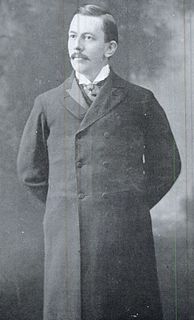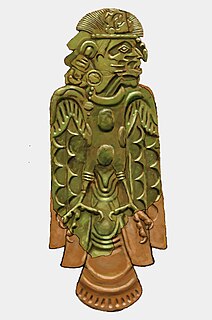
Edward Palmer was a self-taught British botanist and an early American archaeologist.

Etowah Indian Mounds (9BR1) are a 54-acre (220,000 m2) archaeological site in Bartow County, Georgia, south of Cartersville. Built and occupied in three phases, from 1000–1550 AD, the prehistoric site is located on the north shore of the Etowah River.

The Mississippian culture was a Native American civilization that flourished in what is now the Midwestern, Eastern, and Southeastern United States from approximately 800 CE to 1600 CE, varying regionally. It was known for building large, earthen platform mounds, and often other shaped mounds as well. It was composed of a series of urban settlements and satellite villages linked together by loose trading networks. The largest city was Cahokia, believed to be a major religious center located in what is present-day southern Illinois.

A number of pre-Columbian cultures are collectively termed "Mound Builders". The term does not refer to a specific people or archaeological culture, but refers to the characteristic mound earthworks erected for an extended period of more than 5,000 years. The "Mound Builder" cultures span the period of roughly 3500 BCE to the 16th century CE, including the Archaic period, Woodland period, and Mississippian period. Geographically, the cultures were present in the region of the Great Lakes, the Ohio River Valley, and the Mississippi River valley and its tributary waters.

Lake Jackson Mounds Archaeological State Park (8LE1) is one of the most important archaeological sites in Florida, the capital of chiefdom and ceremonial center of the Fort Walton Culture inhabited from 1050–1500. The complex originally included seven earthwork mounds, a public plaza and numerous individual village residences.

The Bureau of American Ethnology was established in 1879 by an act of Congress for the purpose of transferring archives, records and materials relating to the Indians of North America from the Interior Department to the Smithsonian Institution. But from the start, the bureau's visionary founding director, John Wesley Powell, promoted a broader mission: "to organize anthropologic research in America." Under Powell, the bureau organized research-intensive multi-year projects; sponsored ethnographic, archaeological and linguistic field research; initiated publications series ; and promoted the fledgling discipline of anthropology. It prepared exhibits for expositions and collected anthropological artifacts for the Smithsonian United States National Museum. In addition, the BAE was the official repository of documents concerning American Indians collected by the various US geological surveys, especially the Geographical and Geological Survey of the Rocky Mountain Region and the Geological Survey of the Territories. It developed a manuscript repository, library and illustrations section that included photographic work and the collection of photographs.

The Criel Mound, also known as the South Charleston Mound, is a Native American burial mound located in South Charleston, West Virginia. It is one of the few surviving mounds of the Kanawha Valley Mounds that were probably built in the Woodland period after 500 B.C. The mound was built by the Adena culture, probably around 250–150 BC, and lay equidistant between two “sacred circles”, earthwork enclosures each 556 feet (169 m) in diameter. It was originally 33 feet (10 m) high and 173 feet (53 m) in diameter at the base, making it the second-largest such burial mound in the state of West Virginia. This archaeological site is listed on the National Register of Historic Places.

A platform mound is any earthwork or mound intended to support a structure or activity. It typically refers to a flat-topped mound, whose sides may be pyramidal.

Warren King Moorehead was known in his time as the 'Dean of American archaeology'; born in Siena, Italy to missionary parents on March 10, 1866, he died on January 5, 1939 at the age of 72, and is buried in his hometown of Xenia, Ohio.
Arthur Randolph Kelly was an American professional archaeologist. He made numerous contributions to archeology in Georgia, which began with directing excavations at the Macon Plateau Site in 1933, part of the federal archeology program that provided jobs while undertaking studies of important sites. During his career, he also worked at the Etowah Mound and Village site, Lamar Mounds, the Lake Douglas Mound, the Oliver and Walter F. George River Basin surveys, the Estatoe Mound, the Chauga Mound, and the Bell Field Mound, among others in Georgia.
The Bat Creek inscription is an inscribed stone tablet found by John W. Emmert on February 14, 1889. Emmert claimed to have found the tablet in Tipton Mound 3 during an excavation of Hopewell mounds in Loundon County, Tennessee. This excavation was part of a larger series of excavations that aimed to clarify the controversy regarding who is responsible for building the mounds covering the Eastern United States.
The Rembert Mounds (9EB1) is an archaeological site in Elbert County, Georgia in the area that is now under the Clark Hill Reservoir on the Savannah River. The last excavation of the site occurred just before the reservoir was built; Joe Caldwell and Carl F. Miller conducted the excavation during a three-week period between January 12 and June 1, 1948. However, they are not the first people to examine the site. William Bartram first described the mounds in 1773 as: "an imposing group of one large and several smaller mounds standing adjacent to some extensive structures [which he called tetragon terraces]." In 1848, George White claimed "the smaller mounds had been nearly destroyed." Then, Charles C. Jones, Jr. stated that "only traces of the smaller mounds remained and the tetragon terraces were no more than gentle elevations." Less than 10 years later, in 1886, John P. Rogan excavated part of the site under Cyrus Thomas and found only the largest mound and one of the smaller mounds still standing. Rogan's excavation was the last before Caldwell and Miller's excavation in 1948. However, there was a flood in 1908 that almost completely destroyed the large mound.
The Chauga Mound (38OC1) is an archaeological site once located on the northern bank of the Tugaloo River, about 1,200 feet (370 m) north of the mouth of the Chauga River in present-day Oconee County, South Carolina. The earthen platform mound and former village site were inundated by creation of Lake Hartwell after construction of the Hartwell Dam on the Savannah River, which was completed in 1962.

The Wulfing cache, or Malden plates, are eight Mississippian copper plates crafted by peoples of the Mississippian culture. They were discovered in Dunklin County, Missouri in 1906 by Ray Grooms, a farmer, while plowing a field south of Malden. The repousséd copper plates were instrumental to archaeologists' developing the concept known as the Southeastern Ceremonial Complex.

The Etowah plates, including the Rogan Plates, are a collection of Mississippian copper plates discovered in Mound C at the Etowah Indian Mounds near Cartersville, Georgia. Many of the plates display iconography that archaeologists have classified as part of the Southeastern Ceremonial Complex (S.E.C.C.), specifically "Birdman" imagery associated with warriors and the priestly elite. The plates are a combination of foreign imports and local items manufactured in emulation of the imported style. The designs of the Rogan plates are in the Classic Braden style from the American Bottom area. It is generally thought that some of the plates were manufactured at Cahokia before ending up at sites in the Southeast.

Mississippian copper plates, or plaques, are plain and repousséd plates of beaten copper crafted by peoples of the various regional expressions of the Mississippian culture between 800 and 1600 CE. They have been found as artifacts in archaeological sites in the American Midwest and Southeast. The plates, found as far afield as Florida, Georgia, Illinois, Mississippi, Oklahoma, Tennessee, and Wisconsin, were instrumental in the development of the archaeological concept known as the Southeastern Ceremonial Complex. Some of the more notable examples are representations of raptorial birds and avian-themed dancing warriors.
Mound 34 is a small platform mound located roughly 400 metres (1,300 ft) to the east of Monks Mound at Cahokia Mounds near Collinsville, Illinois. Excavations near Mound 34 from 2002–2010 revealed the remains of a copper workshop, although the one of a kind discovery had been previously found in the late 1950s by archaeologist Gregory Perino, but lost for 60 years. It is so far the only remains of a copper workshop found at a Mississippian culture archaeological site.
The Emmons Cemetery Site, also known as the Emmons Site, is a Middle Mississippian culture archaeological site located in Kerton Township, Fulton County, Illinois, on the edge of a bluff overlooking the Illinois River to its east. The location was a used as a cemetery and several unique and rare items were found interred with the burials.
The Carson Mounds,, also known as the Carson Site and Carson-Montgomery- is a large Mississippian culture archaeological site located near Clarksdale in Coahoma County, Mississippi in the Yazoo Basin. Only a few large earthen mounds are still present at Carson to this day. Archaeologists have suggested that Carson is one of the more important archaeological sites in the state of Mississippi.












